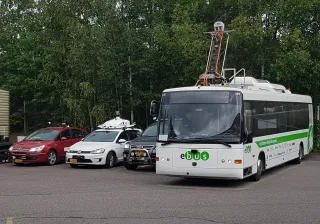Tarva is a tool used to assess the safety of the current transport network as well as the impact and cost of improvement measures. VTT developed the tool 30 years ago, and it is still used today. Harri Peltola, Principal Scientist at VTT, takes us through Tarva’s journey.
Tarva has played a significant part in improving Finnish road safety for three decades. During its existence, it has evolved from its infancy into a fully grown assessment system.
Current users of Tarva include government agencies as well as consultants, companies and educational institutions in the transport sector. In addition, data and calculation methods provided by Tarva have been used in numerous research projects over the years.
Why was Tarva developed?
In the early 1990s, the planning and assessment of measures to improve the traffic environment in Finland was very unstructured. Road safety was mainly assessed by examining the accident history of specific sites, which led to unreliable and unsystematic assessments.
For example, if an exceptionally high number of traffic accidents was observed on a certain road section, measures may have been taken to improve its safety. Sometimes these measures would seemingly lead to a safety improvement, but this was not necessarily due to the measures themselves. Instead, the change may have been due to the tendency for exceptional values to be followed by values closer to average in a phenomenon known as regression to the mean. In practice, this means that the safety of dangerous road sections could have been “improved” even without costly measures – the results could just be normal variation.
“At VTT we started thinking about how road safety could be assessed more accurately and how the assessments of various improvement measures could be made more systematic. Especially Saara Toivonen from the Finnish Road Administration (Tiehallinto) saw the importance of this issue from the start and supported its development”, says Harri Peltola, who continues to work as Principal Scientist in the Transport System team at VTT.
And so the development of a reliable method to calculate the number of accidents and its automation began. In its infancy, the assessment software was given the name Tarva at Harri’s suggestion. The name is an acronym that comes from the words Turvallisuusvaikutusten ARviointi VAikutuskertoimilla (the assessment of safety impact based on impact coefficients). Mikko Virkkunen, who was enthusiastic about developing the new system, took on the work to automate the assessment method. He proved to be an important asset for Tarva’s development.
Tarva 1.1, which was published in 1994, uses the empirical Bayes method for assessing the safety of road sections. The method combines accident history data with accident models, thus reducing statistical bias in the assessments. Furthermore, the impact of different safety measures is based on international research results on their impacts. In this way, all parties assessing safety measures use the same data and impact coefficients, which enables a more reliable comparison of different measures.
What kind of a technological operating environment was Tarva developed for?
The processing of data was slow, and many organisations did not yet have computers at their disposal, or even if they did, they hadn’t yet had the courage to plug them in.
“In the early stages of development, we would take VTT’s computer to what was then the Finnish Road Administration (now the Finnish Transport Infrastructure Agency) for a week to transfer the data to it. The finished Tarva 1.1 was sent to the Finnish Road Administration on two floppy disks. After successful testing, each road district, which would now be called ELY Centres, was sent its own Tarva floppy disks”, Harri explains.
Tarva roused great interest straight away: “Not least because, in the early days, the performance targets of the Finnish Road Administration and its personnel were tied to Tarva.”
In the picture: Harri Peltola

What is Tarva like today?
Three different versions of Tarva have been developed in collaboration with Simsoft, a consultant for its IT implementation. Tarva MT focuses on the safety of Finnish highways, and Tarva LC on railway level crossings. Tarva LT was developed in 2010 for road safety assessments in Lithuania, commissioned by the Lithuanian Road Administration. It was maintained until 2022.
Tarva is still used to assess the safety of the transport network and the safety impact of various improvement measures in Finland. Tarva also helps to assess the safety impact and cost-effectiveness of planned road improvements. This year, the road safety assessment method underlying Tarva will be transferred to the Vala platform.
The Tarva MT database contains information on approximately 75,000 road sections and 23,000 road junctions, and the current state of road safety is been calculated for each. Tarva makes use of reliable and up-to-date information from different sources in a multitude of ways. The information is related to, for example, the road network as well as traffic and road accidents, their severity and location details.
A pioneer of road safety for 30 years
If only other areas of road safety work would be founded on and make systematic use of scientifically well founded tools such as Tarva! Road safety work should be as free as possible from statistical bias in order to have an effective impact.
Finally, we wish to congratulate Tarva on its 30th anniversary and thank Harri, who has been involved in Tarva’s development from its birth! Many thanks to the parties who have funded Tarva’s development, in particular the Finnish Transport Infrastructure Agency and the Finnish Transport and Communications Agency Traficom.
Additional reading
Peltola, H. (2009) Evaluating road safety and safety effects using Empirical Bayesian method. In 4th IRTAD Conference, Seoul, Korea. https://www.itf-oecd.org/sites/default/files/docs/8-peltola.pdf
Peltola, H., Rajamäki, R. & Luoma, J. (2013) A tool for safety evaluations of road improvements. Accident Analysis & Prevention, 60, 277–288. https://doi.org/10.1016/j.aap.2013.04.008






